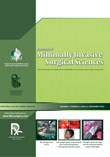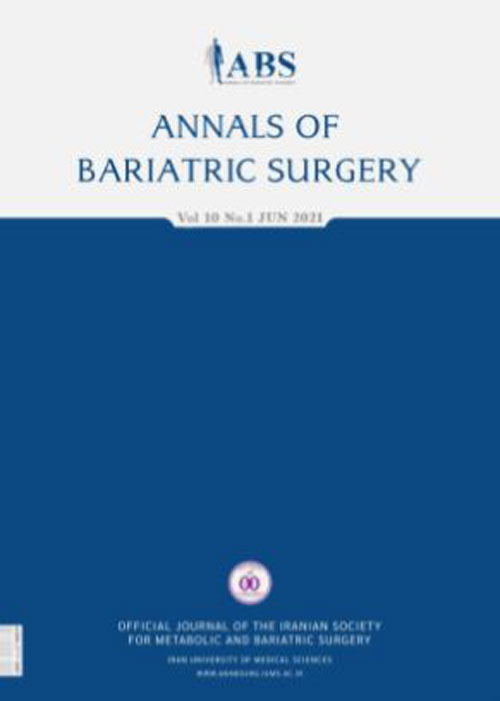فهرست مطالب

Annals of Bariatric Surgery
Volume:4 Issue: 4, Autumn 2015
- تاریخ انتشار: 1394/08/04
- تعداد عناوین: 5
-
-
Page 2IntroductionA cholecystocutaneous fistula an abnormal epithelial tract that allows communication between the gallbladder and the skin, manifests as a rare complication of gall stones.The treatment of choice is definitive surgical excision of both the gallbladder and the tract, usually by an open operation. However, a laparoscopic approach is another option, especially if the patient is elderly and has other co morbidities. We report a case of a laparoscopically managed cholecystocutaneous fistula.Case PresentationA 55-year-old male with comorbidities presented with a discharging sinus at the right upper quadrant area after an abdominal wall abscess drainage. A Computerized tomography scan showed a biliary fistula. Laparoscopic cholecystectomy was carried out successfully.ConclusionsLaparoscopic cholecystectomy is a safe and feasible technique to manage cholecystocutaneous fistulas.Keywords: Biliary Fistula, Laparoscopic Cholecystectomy, Galls Stones
-
Page 3BackgroundChronic complications of symptomatic gallstone disease such as Mirizzi’s syndrome are rare. The importance and implications of these conditions are related to their associated surgical complications which are potentially serious such as bile duct injury and to the modern management when encountered during laparoscopic cholecystectomy.ObjectivesThis research offers a technique to avoid surgical complications in Mirizzi’s syndrome cases during laparoscopic cholecystectomy. Patients andMethodsBetween November 2012 and February 2015, 17 patients (12 females and 5 males) with mean age of 51 years (between 29 and 57 years) suffering from Mirizzi’s syndrome underwent the divided cholecystectomy. In this technique the gall bladder was divided into two parts above the gall bladder infundibulum. The distal part was dissected for short distance and used to push liver up. The proximal part of gall bladder was cleared from all its contents and reevaluated from inside. Management was achieved according to the stage of disease.ResultsThe mean operative time was 70 minutes (between 60 and 90 minutes). No biliary tract obstruction or leakage or stenosis was recorded in this patient group during the period of follow up (18 months).ConclusionsDivided laparoscopic cholecystectomy is a safe and effective technique to face the unusual gallstones complications (Mirizzi’s syndrome).Keywords: Divided, Laparoscopic Cholecystectomy, Mirizzi's Syndrome
-
Page 4BackgroundIn 2005، obesity rate was declared 396 million worldwide، which has been doubled in the last 20 years (compared with 1985). Obesity has a strong correlation with a pool of comorbidities and consequences. Although many modules، including behavioural approach and medications have presented particular short-term unreliable methods to reduce and control the body weight in morbid obesity، only 5 - 10% of weight loss was achieved، which is usually regained overtime، compared with 50 - 75% success rate in bariatric surgery.ObjectivesThis retrospective study tried to monitor weight loss after LRYGB and LSG in morbid obese patients referred to a known center in Tehran through a one-year follow up.Materials And MethodsParticipants were selected regarding the U. S. National Institute of Health (NIH) guidelines، which indicates BMI > 40 kg/m2 alone، or BMI > 35 kg/m2 in addition to comorbidities and failure of non-surgical attempts to control their weight. They were visited at points of one، three، six، and 12 months postoperatively to collect information about weight loss، BMI، and complications in addition to percent excess weight loss (EWL%). The percentage of failure was computed to the proportion of patients who had EWL% < 25 to the total number of operated patients in a year.ResultsSignificant decrease in BMI and weight were achieved in all postoperative visits (for all of them، P value < 0. 0001)، while no significant difference was found in which the parameters between two studied procedures were in this regard.ConclusionsTo sum up، LRYGB and LSG deserve an overall preference not only in current study، but also in the majority of performances up to now. Nevertheless it is urgent the relevant studies to confirm the preference or improve this kind of bariatric surgery in order to diminish complications as far as possible.Keywords: Obesity, Morbid, LRYGB, LSG, Iran
-
Page 5BackgroundLaparoscopic cholecystectomy (LC) was first introduced in the late 80’s, replacing open cholecystectomy as the standard surgical approach for cholelithiasis in developed countries. In contrast, there were initially many controversies in developing countries regarding the laparoscopic techniques.ObjectivesThis study aimed to compare the early outcomes and costs between laparoscopic and open cholecystectomy for cholelithiasis in a rural hospital in a developing country. Patients andMethodsThis retrospective study included all consecutive patients who underwent cholecystectomy for mild and moderate symptomatic gallstone, in the Marche Verte hospital, in the Boulemane province in Morocco between January and December 2011. Demographics, postoperative outcomes, and costs were compared between laparoscopic and open surgery groups. Duration of hospital stay was calculated from the time of operation to the time of discharge. The total costs for each patient included the sum of: the average hospitalization costs per day; the average operating room costs; and material and medications costs. Chi-square test or Fisher’s exact test and student or Mann-Whitney U tests were used for comparison, as appropriate.ResultsDuring the study period, 95 patients were included; among them, 53 patients underwent laparoscopic surgery and 42 laparotomy. There were no statistical differences between the two groups concerning age, gender distribution, American society of anesthesiologists (ASA) classification, and number of acute cholecystitis. Rate of conversion to open surgery was 5.6% (3 patients). Patients in the laparoscopic group had shorter hospital stay (2.9 vs. 4.7 days, P = 0.0001), lower rates of infectious complications (3.7% vs. 16.6%, P = 0.04), and lower costs (169 vs. 231.62 US dollars, P = 0.0001).ConclusionsThe results of the present study showed that, in a rural hospital setting in a developing country, laparoscopic cholecystectomy for symptomatic cholelithiasis was associated with shorter hospital stay, less infectious morbidity rates, and reduced costs, compared to open surgery. Thus, laparoscopic cholecystectomy should be advised as a routine technique for management of cholelithiasis in rural areas of developing countries.Keywords: Laparoscopic Cholecystectomy, Rural Surgery, Treatment Outcomes, Comparative Study


